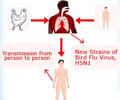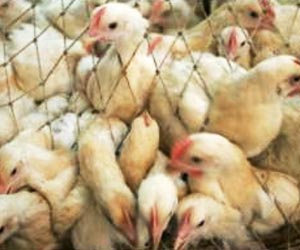Exploring the bird flu outbreak in the US, its impact on food safety, and measures to mitigate risks to human health.
- Bird flu, primarily affecting poultry and wild birds, has spread to domestic animals like dairy cows
- Proper cooking and pasteurization of eggs, meat, and milk are essential to reduce infection risks
- Ongoing monitoring and proactive measures by health authorities are vital in safeguarding public health during the outbreak
Bird flu has spread to more farm animals. Here's what to know about food safety
Go to source).
Bird flu has spread to dairy cows in 8 US states, raising concerns about food safety. #birdflu #foodsafety #medindia’
Impact on Domestic Animals and Food Safety Concerns
Avian influenza commonly known as bird flu, is notorious for its devastating impact on poultry and wild bird populations worldwide. However, the recent outbreak's spread to domestic animals, including dairy cows, has heightened apprehensions about the safety of consuming animal products such as eggs, meat, and milk. Although cows show milder symptoms compared to birds, such as reduced milk production and lethargy, the spread within mammalian species is concerning (2✔ ✔Trusted SourceIs This Bird Flu Outbreak a Wake-Up Call? Here's What You Need to Know
Go to source).
This outbreak has prompted critical questions and considerations regarding food safety practices, as consumers and authorities alike seek to understand the risks associated with consuming products from affected animals. The implications extend beyond agriculture, touching upon broader public health concerns and necessitating informed measures to mitigate potential health risks to humans.
Agricultural officials are monitoring closely, with restrictions on cattle imports from affected states. However, commercial milk production remains largely unaffected. The virus is believed to be transmitted through exposure to wild birds, though cow-to-cow spread is not ruled out.
States Affected by Bird Flu in Dairy Cows
The strain of bird flu, specifically Type A H5N1, which has previously impacted wild bird populations, has now been detected in at least 26 dairy herds across eight U.S. states. The affected states include:Idaho, Kansas, Michigan, New Mexico, North Carolina, Ohio, Texas, and South Dakota.This marks the first occurrence of the bird flu virus being found in cattle, according to federal health and animal agencies. Genetic analysis by the U.S. Centers for Disease Control and Prevention (CDC) indicates that the virus has not undergone changes to facilitate easier spread among humans. The spread of bird flu to domestic animals, particularly dairy cows, raises significant concerns about animal health and potential implications for food safety.
Fatality and Impact of Bird Flu
While bird flu primarily affects birds, it can also pose risks to humans rarely. The virus may initially manifest with mild symptoms such as conjunctivitis (pink eye) or flu-like symptoms. However, in some cases, especially with certain strains like H5N1, bird flu can lead to severe respiratory illness and even death.The mortality rate for humans infected with bird flu is relatively high compared to other types of influenza. Individuals with compromised immune systems, underlying health conditions, or those with prolonged exposure to infected birds or contaminated environments are at greater risk of developing severe complications.
It's essential to note that human-to-human transmission of bird flu is rare, typically occurring through close contact with infected birds or their secretions. However, ongoing surveillance and monitoring of outbreaks in both bird and human populations are crucial to identifying and managing potential health threats associated with bird flu. Prompt medical attention and public health measures are essential in mitigating the impact of bird flu on human health and preventing the spread of the virus.
Safety of Eggs and Meat
EggsThe detection of bird flu in chickens by the largest US egg producer has led to the culling of affected birds as a precautionary measure. Despite this, experts emphasize that properly handled and thoroughly cooked eggs remain safe for consumption. Cooking eggs to an appropriate temperature ensures any potential pathogens, including bird flu virus, are destroyed. Ongoing vigilance and adherence to food safety guidelines are recommended to minimize risks associated with bird flu contamination in eggs.
Meat
Fortunately, beef cattle have not exhibited signs of infection with bird flu. Nonetheless, it's crucial to practice proper food handling and cooking techniques when preparing meat. Cooking meat thoroughly to the recommended internal temperature helps ensure the elimination of any potential pathogens, including those associated with bird flu, thereby enhancing food safety.
Milk Safety and Pasteurization
Grocery Store MilkPasteurization, a heat-treatment process used in commercial milk production, effectively eliminates viruses like bird flu from milk. Milk from sick cows is promptly identified, diverted, and destroyed to prevent it from entering the consumer market. This stringent protocol helps maintain the safety and integrity of commercially available milk, reassuring consumers about the quality of dairy products amidst the bird flu outbreak.
Raw Milk
The FDA and CDC caution against consuming raw milk, particularly during disease outbreaks like bird flu, due to limited information regarding virus transmission through unpasteurized products. While raw milk enthusiasts may prefer its taste or purported health benefits, the risks associated with potential contamination by pathogens, including bird flu virus, underscore the importance of opting for pasteurized milk for enhanced safety and reduced health risks.
Despite the recent cases of bird flu in humans, the overall risk to the general public remains low. This is largely attributed to proper cooking methods and pasteurization of food products, which effectively minimize the risk of infection from bird flu virus.
In response to the outbreak, consumers are strongly encouraged to adhere to food safety guidelines, including thorough cooking of eggs and meat, and opting for pasteurized dairy products. These measures help mitigate potential health risks associated with consuming animal products during the bird flu outbreak.
Ongoing monitoring and proactive measures by health and agricultural authorities are crucial in safeguarding the food supply and maintaining consumer confidence. As the situation evolves, it is imperative to stay informed and continue practicing established safety measures to minimize any potential risks associated with bird flu transmission through food sources. By collectively adopting these precautions, we can help ensure food safety and protect public health amidst the challenges posed by the bird flu outbreak.
References:
- Bird flu has spread to more farm animals. Here’s what to know about food safety - (https://www.pbs.org/newshour/health/bird-flu-has-spread-to-more-farm-animals-heres-what-to-know-about-food-safety)
- Is This Bird Flu Outbreak a Wake-Up Call? Here’s What You Need to Know - (https://www.peta.org/living/food/bird-flu-meat-dairy-eggs/)
Source-Medindia















